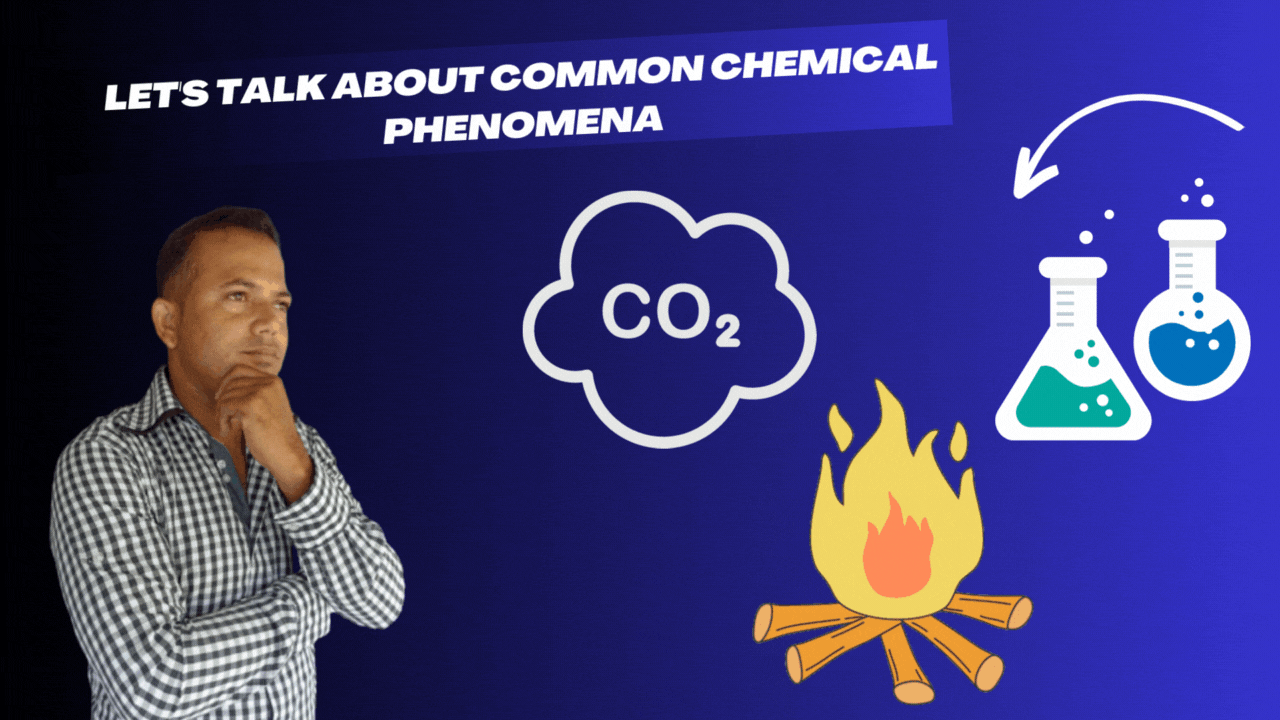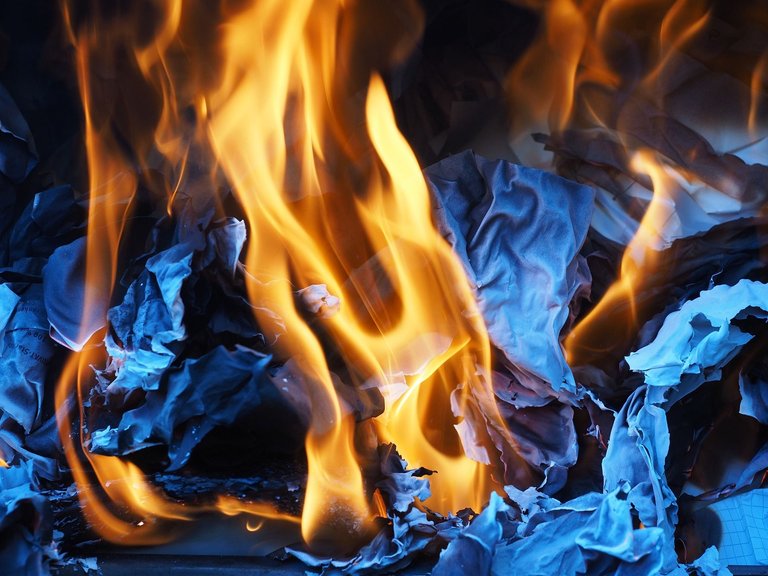LET'S TALK ABOUT COMMON CHEMICAL PHENOMENA
Human development has allowed us to understand the behavior of matter, which has undoubtedly led us on a path of constant change and evolution, in search of approaching the strangest phenomena that occur around us. So we have been able to manipulate the structure and composition of matter, all in order to improve our quality of life on the planet, from the various materials that we manage to obtain from matter itself.

In this sense, and in order to contextualize the above, it is valid to generate a turning point that will serve as a support for the approach to the advances of science in terms of the chemical phenomena that we have to explain.
Based on the above, we will be making a quali-quantitative approach to two determinant phenomena in the history of science, mentioning the process of wood decomposition and the combustion of paper.

CHEMICAL PHENOMENA IMMERSED IN HUMAN LIFE

Earlier we mentioned that, throughout this paper, we will focus on two chemical phenomena immersed in our lives, which we will describe below:
1. Chemical processes behind wood decomposition.
The chemistry behind this biological process responds directly to the carbohydrates cellulose and lignin, both of which are present in the structure of wood and are directly responsible for its decomposition. Therefore, responsible agents are required for this task and among them we can find a group of fungi called ligninolytic fungi.
These species are capable of attacking the catalytic center of all those carbohydrates that contain lignin in their structure and, as is to be expected at the biochemical level, have the capacity to release the enzyme lignase, responsible for causing the decomposition process of a larger substance to its simplest components, i.e., the monomers, resulting in the production of carbon dioxide and water. The chemical process can be represented by the following equation.

Starting from the above chemical equation, let's analyze the following scenario, suppose we decompose 200 grams of wood product of an enzymatic process catalyzed by lignase, based on this, determine the amount of moles of lignin that will be decomposed and how many moles of carbon dioxide will be generated. It is necessary to assume in our calculation that the wood contains 40% lignin.
Suggested data:
Step 1: Determine the average molar mass of lignin using the web browser = 170 g/mol.
Step 2: Determine the mass of lignin in the wood sample, considering the percentage of lignin present.
Since we have established that wood contains 40% lignin, we can calculate the mass of lignin in the 200 grams of wood product as follows:

Step 3: Determine the number of moles of lignin.
In this section, we need to know the molecular weight of lignin, but for this we need to know that lignin is a complex organic polymer and its molar mass can vary. However, to solve this problem, let us assume an average molar mass of 170 g/mol for lignin.

Step 4: At this point, we only need to establish the amount of carbon dioxide as a by-product of the chemical reaction, for this, we need to focus on stoichiometry, as a working methodology that allows us to evaluate the transformation and behavior of moles and masses in each of the substances involved in the process.
Therefore, and based on the above, we can see from the above chemical equation that it does not provide us with a true stoichiometric relationship that allows us to study in depth the correlations between reactants and products, which is why we have decided to establish the stoichiometry of the phenomenon in a 1:1 ratio.
So: 1 mole of lignin produces 1 mole of carbon dioxide, the 0.470 moles of lignin how many moles of carbon dioxide it will produce, mathematically it would look like this:

When following the above sequence, it is normal to find that it responds to a reaction order, where it is the stoichiometric process that allows us to extract valuable information from it and studying this type of phenomena we can find its implications at the level of understanding the ecosystems and the bioremediation process, since in both usually occur enzymatic decomposition by the presence of microorganisms.
This undoubtedly allows us to study the process of reuse of nutrients at an ecological level, and also offers a greater breadth of knowledge regarding the behavior of ligninolytic fungi and their action as species capable of degrading organic pollutants that may affect our environment.
2. Chemical processes behind paper combustion.
The chemical process involved in this phenomenon has as its starting material the second component present in wood, cellulose, which is why it is assumed to be a process that releases considerable amounts of energy in the form of heat, an aspect known in chemistry as an exothermic process. The chemical reaction that takes place is the following:

Looking at the chemical equation above, we can notice that the products generated in the combustion of cellulose is carbon dioxide and water and as a consequence of the energy released it is normal that we get ash residues.

Image courtesy of: Hans
In this sense and when studying the usefulness of this phenomenon, we can find that it has great use in calorimetric processes, understood as the process that allows measuring the changes in the state variables of a body, which facilitates determining the heat transfers associated with the changes produced.
This utility is essential in understanding the energy and caloric contribution of food, as well as in the characterization of fuels. Moreover, the study associated with cellulose combustion has made it possible to improve the safety of certain materials, especially those used in the covering of houses, whose fundamental characteristic is to be fireproof.
Therefore, and based on the above, let us analyze the following case study, suppose that at laboratory level and under controlled conditions, 500 grams of paper, whose main component is cellulose, is subjected to complete combustion and assuming that all the carbon in the cellulose is converted into carbon dioxide, determine how many moles of cellulose are consumed and how many moles of carbon dioxide are produced.
Suggested data:
Step 1: Determine the average molar mass of cellulose using the web browser = 162 g/mol.
Step 2: Determine the moles of cellulose present in the sample supplied, in this sense, it is common to use the molecular weight of the substance to perform this mathematical calculation, it would be as follows:

Step 3: Determine the moles of carbon dioxide produced, for this point, we will rely on the stoichiometric ratios of the process, so that assuming a 1:1 ratio we can infer that the same amount of cellulose consumed, will be the amount of dioxide produced, applying the principles of conservation of mass.
Consequently, both the process of wood decomposition and paper combustion represent a type of phenomena that mankind has used to improve and facilitate our quality of life, both are assumed to be biological processes that involve reactions from organic compounds that in many cases release energy accompanied by water and carbon dioxide.

FINAL CONSIDERATIONS

Throughout the paper we can observe in a qualitative and practical way the behavior and usefulness of various chemical phenomena that respond to a state of decomposition of organic compounds that has allowed mankind to understand the matter and the transformation that it is capable of undergoing to generate new materials that are very useful due to their various applications.
Thus, through these lines of writing, we were able to observe how quantitative calculations allow us to generate a broader vision of chemical phenomena and the quantities of substances involved in them, as well as the behavior of the chemical reactions involved in these processes and their impact on the environment and the various ecosystems that compose it.

BIBLIOGRAPHIES CONSULTED

[1] Brown, T. L., LeMay, H. E., Bursten, B. E., & Murphy, C. J. (2017). Química: La Ciencia Central. Pearson.
[2] Paul, E. A. (Ed.). (2007). Soil Microbiology, Ecology, and Biochemistry. Academic Press.
[3] Ralph, H. Petrucci, William S. Harwood, E. Geoffrey Herring. (2003). GENERAL CHEMISTRY. Eighth edition. PEARSON EDUCACIÓN.S.A., Madrid.
[4] Rees, R. M. (Ed.). (2018). Understanding and Modelling the Carbon and Nitrogen Cycles in Soils. John Wiley & Sons.

OF INTEREST


0
0
0.000
Thanks for your contribution to the STEMsocial community. Feel free to join us on discord to get to know the rest of us!
Please consider delegating to the @stemsocial account (85% of the curation rewards are returned).
You may also include @stemsocial as a beneficiary of the rewards of this post to get a stronger support.